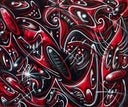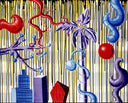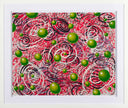About the Artist
Kenny Scharf (b.1958) is a defining figure of contemporary art whose radiant, cartoon-inspired universe has shaped the visual culture of the last four decades. Born in Los Angeles in 1958, Scharf moved to New York in the late 1970s to attend the School of Visual Arts, immersing himself in the groundbreaking downtown art scene of the East Village. Alongside contemporaries like Keith Haring and Jean-Michel Basquiat, Scharf forged a new aesthetic that blurred the boundaries between street art, pop culture, and fine art. For him, art was never confined to the gallery, it was an all-encompassing experience meant to inspire joy, curiosity, and wonder in everyday life.
At the heart of Scharf’s work lies a fantastical collision of imagery: day-glo biomorphic forms, intergalactic dreamscapes, and cartoon characters refracted through a surreal, hallucinatory lens. Deeply inspired by the television culture of his youth—programs like The Jetsons, The Flintstones, and Disney’s Fantasia—his paintings channel a “future nostalgia” that feels at once playful and subversive. Scharf’s signature style, with its neon palettes and cosmic whimsy, embodies exuberance, optimism, and humor, while also hinting at the tension between utopia and dystopia.
Scharf has always sought to democratize art by bringing it beyond traditional walls. His immersive installations, including the famed Cosmic Caverns, invited viewers into fluorescent environments filled with music, sculpture, and painting, transforming the gallery into an otherworldly playground. His murals, whether in New York, Brazil, or Tokyo, carry that same ethos of accessibility, offering spontaneous delight to public audiences.
Beyond his paintings and installations, Scharf gained recognition for his early graphic work beginning in the 1980s. These bold, playful prints and multiples helped cement his reputation as an artist whose language could move seamlessly between mediums. Bright, saturated, and infused with the artist’s signature surreal cartoon energy, these graphic works remain highly sought after by collectors, embodying both the spirit of the era and the enduring vitality of Scharf’s vision.
Scharf’s impact on contemporary art is underscored by his inclusion in major museum collections around the world, from the Museum of Modern Art and the Whitney Museum of American Art in New York, to MOCA Los Angeles, the Guggenheim, the Stedelijk Museum in Amsterdam, and institutions in Tokyo, Rio de Janeiro, and Cologne. His career has been punctuated by landmark exhibitions, including his participation in the historic Times Square Show (1980), the Whitney Biennial, and major retrospectives such as the 2024 Brant Foundation exhibition in New York, which celebrated the evolution and resilience of his practice over more than four decades.
Scharf’s work continues to perform strongly in the global art market, with significant results at Christie’s and Sotheby’s confirming both institutional and private demand. His paintings, limited editions, and collaborative projects with cultural brands and design houses expand his reach across generations of collectors, reinforcing his dual identity as both a cultural icon and a serious painter of lasting significance.
For Scharf, art is as much about uplift as it is about aesthetics: a refusal to allow cynicism to eclipse creativity. His canvases, murals, and graphic works are filled with life-imaginative worlds where biomorphic creatures, cosmic fantasies, and cartoon humor collide. At once nostalgic and futuristic, his art invites viewers to consider the possibility of joy as an essential human act.










